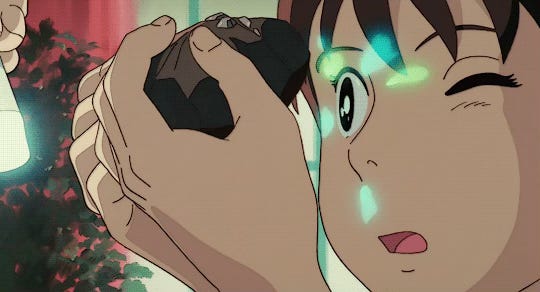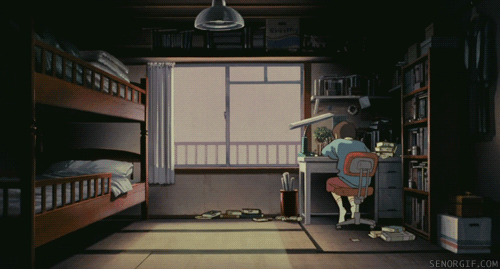
Books and diaries – and the act of writing in general – have always fascinated me. Growing up, I’ve kept many diaries and started many stories but finished none. So instead, I lived vicariously through characters who do finish what they started.
My dad used to put on a movie for me every morning before primary school. I’d eat my breakfast as he popped a DVD into the machine. Some days, I’ll watch Beauty and the Beast (1991); other days, I’ll watch Bolt (2008). But most days, I watched Whisper of the Heart (1995).
The movie opens up with Olivia Newton-John’s cover of Take Me Home, Country Roads, and amidst the crowded nightlife of Tama, Tokyo, we slowly zero in on a girl as she makes her way home from the convenience store.
Directed by Yoshifumi Kondō, Whisper of the Heart is based on Aoi Hiiragi’s manga under the same name and follows voracious reader Shizuku Tsukishima as she navigates school, first love, and the uncertainty of the future.
It’s the summer before Shizuku’s last year in junior high. Instead of studying for her high school entrance exams, she spends most of her time reading. She notices that all the books she’d read over summer break were all previously borrowed by the same person: Seiji Amasawa. It seems as though he’s always one book ahead of her. Curious, she sets out on finding him.
When Shizuku encounters a cat on a train, she decides to follow it and turns up at an antique store. Here, she meets the owner Shirō Nishi and his grandson Seiji Amasawa. Despite getting off on the wrong foot with Seiji, Shizuku and him soon become friends.
This newfound friendship, however, is interrupted when Seiji sets out for Cremona, Italy to pursue his violin-making dreams. This inspires Shizuku to charge down her own path as well. She decides that she’ll write a book.
There is a scene I return to every time I encounter a creative block. It’s when Shizuku goes to Shirō and tells him about her writing aspirations. The shop owner is excited that she is following her passion, just like his grandson, and decides to show her a geode. Not registering the geode’s uniqueness at first, Shizuku says, “It’s just a rock.”
He tells her: “It’s a special kind of rock called a geode… There are pieces of raw emeralds deep inside them. Emeralds are worth a lot of money, but they need to be cut and polished first. When you first become an artist, you’re like that rock. You’re in a raw, natural state, with hidden gems inside. You need to dig down deep and find the emeralds tucked away inside you.”
I like to think that this quote applies to both you as an artist, and whichever project you are working on. When you start out, your idea is a geode; it’s in its raw, natural state. You need to carve inside the idea to uncover all the special aspects. Then, you’ll need to polish it.
When I completed my first novel, I was eighteen. I was proud. So, so proud. But the adrenaline and pride was quickly smothered by the realization that this is one of the worst stories ever written in the history of stories. Back then — and sometimes even now —I seemed to have forgotten that what I just completed wasn’t the final story.
As artists, we want our projects to be the best it can be that we often forget a first draft is just that: a first draft. It is the first of many drafts before you get to the Final Product. Every project is a geode, and like every geode, it needs to be cut and polished.
What I absolutely adore about Whisper of the Heart is that we don’t get a montage of Shizuku writing her book; going from struggle to success in a matter of minutes. Instead, we delve deep into the ups and downs of creating art. We see Shizuku excited to start the story, but as the movie progresses, she begins to struggle.
Shizuku prioritizes her novel, and in turn, falls behind in school. Her older sister is worried about her, her parents are worried about her, but she is convinced she’s making the right decision by going after her dream.
Soon, she watches her older sister move out and get her life together, yet Shizuku is still in the same place as before, unsure of what her future holds.
There’s this one scene where Shizuku wakes up at her desk, and in the tiredness of it all, she rolls to the ground, teary-eyed. She finally gets the full room; her bed pushed all the way to the other side, where her sister used to sleep. We see how empty the area is without her sister, and in turn, we see a representation of how Shizuku is feeling.
It’s not an unknown fact that writing is lonely. But it’s lonelier when you’re watching everyone around you move on with their lives, graduating college, landing jobs, starting families. Yet you’re still here: at the same high school graduation table, working on the same draft, dreaming the same dream that one day someone will like the words you write, and you wish that first someone would be yourself.
I started listening to the audiobook for Lily King’s Writers and Lovers this week. On my way to work, I hear Casey’s landlord ask, “What do you have to say?”
Casey thinks to herself: I don’t write because I think I have something to say. I write because if I don’t, everything feels even worse. In that moment, I felt seen in a way that not even a train full of people during rush hour could make me feel.
Writing is both a friend and a foe. Friend, in that there’s no other way for me to feel what I feel without it; and foe, when the words don’t sound like how I want them, and the frustration morphs into an angry arrow aimed at myself.
Shizuku finishes her novel in a frenzy; rushing through it for the sake of finishing. Then, she shows her draft to Shirō. He closes the store and spends the day reading while Shizuku waits in Seiji’s violin studio as she can’t bear to watch someone read her writing.
It’s nighttime when Shirō finally finished reading, and he tells Shizuku that her story is good. But she’s convinced he’s lying. She expresses her dislike towards the draft and tells him all the things that are wrong with her story.
And to this, he responds: “It’s just a bit rough, like Seiji’s violin. But what I read was raw and heartfelt.” He goes on to say that she’s done a great job at carving out the story. Now, she just needs to polish it.
Then he gifts Shizuku with the geode; a reminder of the talent we all have within ourselves.
In our final minutes in Shizuku’s world, we see Seiji return from Cremona, Italy. He visits Shizuku just before dawn and the two bike across the city we now know so well. Seiji tells her, “My teacher says I’m not great yet, but I could be.”
The message is as clear as the dawn breaking across Tama, Tokyo.
Art is a valley of mountains. Once you arrive at the peak of one, there will always be another mountain greater and taller than the one you just overcame. This, however, doesn’t mean your previous accomplishment is unworthy of praise and acknowledgement. If there’s anything Whisper of the Heart taught me, it’s that there needs to be a balance in art: the celebration of what you just created and the acceptance that there is room for improvement.
(Of course, as artists we feel as though there is always something to improve and there comes a time when we need to let go of our art, but that’s a topic for another day.)
Seiji and Shizuku arrive at a hill that overlooks the city. Here, they vow to continue to pursue and polish their art. Together. The movie ends with a sunrise, signaling the start of a new day — and another chance to try again.
As always, thank you for reading and for offering me a space in your inbox <3 You can find me on instagram/threads and tumblr.
Much love,
Thy








this literally made me want to write again uhhhh i love it and appreciate ur words always
Thy this was beautiful